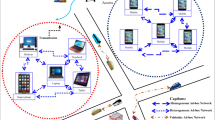Abstract
In ad hoc networks, a significant amount of energy available to devices is utilized in network management operations. Since devices have limited energy resources, therefore, they drop data packets of other nodes to reduce their energy consumption. This selfish behaviour increases number of retransmissions over the link which increases energy consumption of the source node, introduces time delays, and degrades throughput of the network. Although conventional distributed topology control solutions minimize energy utilization of the nodes by adjustment of transmission power, however, selfish behaviour by devices introduce additional complexity in design which make topology control a challenging task. In this paper, we proposed Energy Efficient Topology Control Algorithm (EETCA) using game theoretical approach, in which, utility of the node depends on selfishness of the neighbors, link traffic rate, and link length. In decision-making step, nodes remove the links with other nodes that have high drop rate under the condition that network remains connected. We show that Nash Equilibrium point of the proposed game results in Pareto optimal network topology. We compare results of EETCA with Optimum (OPT) and Minimum Least Power Path Tree (MLPT) algorithms presented in literature. We carried our simulations under multiple sources scenario which show that EETCA outperforms previous approaches when number of nodes in the network increases. Furthermore, we simulate the performance of Ad-hoc On-demand Distance Vector (AODV) routing protocol under EETCA topology and compare it with MLPT and OPT topologies. The results show that the ad hoc network constructed using proposed solution substantially improves throughput of AODV routing protocol as compared to MLPT and OPT topology control algorithms.





Similar content being viewed by others
References
Xu, Y., Bien, S., Mori, Y., Heidemann, J., & Estrin, D. (2013). Topology control protocols to conserve energy in wireless ad hoc networks. In Technical Report 6, Center for Embedded Networked Computing, University of California, Log Angeles.
Kiryang, M., Yoo, D. S., Wonjun, L., & Oh, S. J. (2014). Receiver cooperation in topology control for wireless ad-hoc networks. IEEE Transactions on Wireless Communications, 14(4), 1858–1870.
Abbasi, M. J., Bin, A. L., Shafie, M., & Chizari, H. (2013). An overview of distributed energy-efficient topology control for wireless Ad Hoc networks. Mathematical problems in engineering. Cairo: Hindawi Publishing Corporation. doi:10.1155/2013/126269.
Yakine, F., & Idrissi, A. (2015). Energy-aware topology control and QoS routing in ad-hoc networks. Procedia Computer Science, 56, 309–316.
Torkestani, J. A. (2015). An energy efficient topology control mechanism for wireless sensor networks based on transmit power adjustment. Wireless Personal Communications, 82(4), 2537–2556.
Zhao, H., Guo, S., Wang, X., & Wang, F. (2015). Energy-efficient topology control algorithm for maximizing network lifetime in wireless sensor networks with mobile sink. Applied Soft Computing, 34, 539–550.
Tan, Q., Wei, A., Han, Y., Liu, Y., Ci, S., Fang-Ming, S., et al. (2015). Energy harvesting aware topology control with power adaptation in wireless sensor networks. Ad Hoc Networks, 27, 44–56.
Zhu, Y., Huang, M., Chen, S., & Wang, Y. (2012). Energy-efficient topology control in cooperative ad hoc networks. IEEE Transactions on Parallel and Distributed Systems, 23(8), 1480–1491.
Chen, B., Zhang, Y., Dou, J., & HAO, X. (2012). A strategic game based equilibrium topology control algorithm for wireless sensor networks. Journal of Information and Computational Science, 9(18), 5665–5673.
Alizadeh, Y., Sabaei, M., & Tavallaie, O. (2013). Game theoretic modeling of joint topology control and forwarding in MANET based on local information. In 2013 5th International conference on computational intelligence and communication networks (CICN) (pp. 105–110).
Liu, J., Wang, Y., & Wei, G. (2013). Distributed topology control based on coalition formation game in wireless networks. The Computer Journal, 56(8), 968–976.
Xiao-Chen, H., Ya-Xiao, Z., Jia, N., & Liu, B. (2013). Virtual game-based energy balanced topology control algorithm for wireless sensor networks. Wireless Personal Communications, 69(4), 1289–1308.
Abbasi, M. J., & Fisal, N. (2015). Noncooperative game-based energy welfare topology control for wireless sensor networks. IEEE Sensors Journal, 15(4), 2344–2355.
Zarifzadeh, S., Yazdani, N., & Nayyeri, A. (2012). Energy-efficient topology control in wireless ad hoc networks with selfish nodes. Computer Networks, 56(2), 902–914.
Liu, Q., Jia, X., & Zhou, Y. (2011). Topology control for multi-channel multi-radio wireless mesh networks using directional antennas. Wireless Networks, 17(1), 41–51.
Komali, R. S., & MacKenzie, A. B. (2009). Analyzing selfish topology control in multi-radio multi-channel multi-hop wireless networks. In IEEE International conference on communications.
Santi, P. (2005). Topology control in wireless ad hoc and sensor networks. ACM Computing Surveys (CSUR), 37(2), 164–194.
Li, N., Hou, J. C., & Sha, L. (2005). Design and analysis of an MST-based topology control algorithm. IEEE Transactions on Wireless Communications, 3(4), 1195–1206.
Miyao, K., Nakayama, H., Ansari, N., & Kato, N. (2009). LTRT: An efficient and reliable topology control algorithm for ad-hoc networks. IEEE Transactions on Wireless Communications, 8(12), 6050–6058.
Chen, S., & Nahrstedt, K. (1999). Distributed quality-of-service routing in ad hoc networks. IEEE Journal on Selected areas in Communications, 17(8), 1488–1505.
Xiong, N., Huang, X., Cheng, H., & Wan, Z. (2013). Energy-efficient algorithm for broadcasting in ad hoc wireless sensor networks. Sensors, Multidisciplinary Digital Publishing Institute, 13(4), 4922–4946.
Martin, M. (2008). The saga of minimum spanning trees. Computer Science Review, 2(3), 165–221.
Zhang, G., Lu, J., & Gao, Y. (2015). Multi-level decision making: models, methods and applications. Berlin: Springer.
Romp, G. (1997). Game theory: Introduction and applications. Oxford: Oxford University Press.
Author information
Authors and Affiliations
Corresponding author
Rights and permissions
About this article
Cite this article
Waqas, A., Mahmood, H. A Game Theoretical Approach for Topology Control in Wireless Ad Hoc Networks with Selfish Nodes. Wireless Pers Commun 96, 249–263 (2017). https://doi.org/10.1007/s11277-017-4165-8
Published:
Issue Date:
DOI: https://doi.org/10.1007/s11277-017-4165-8




